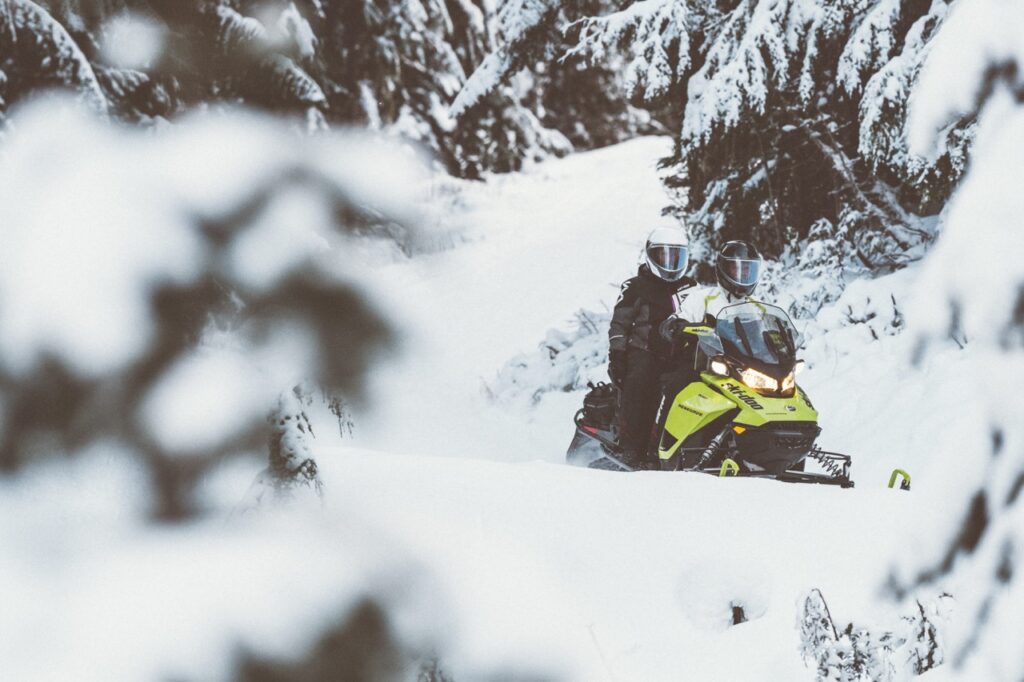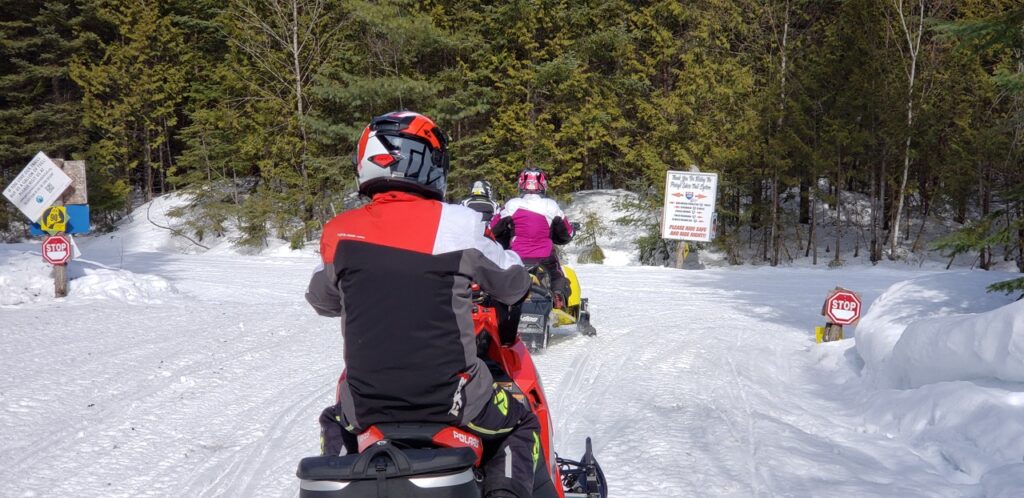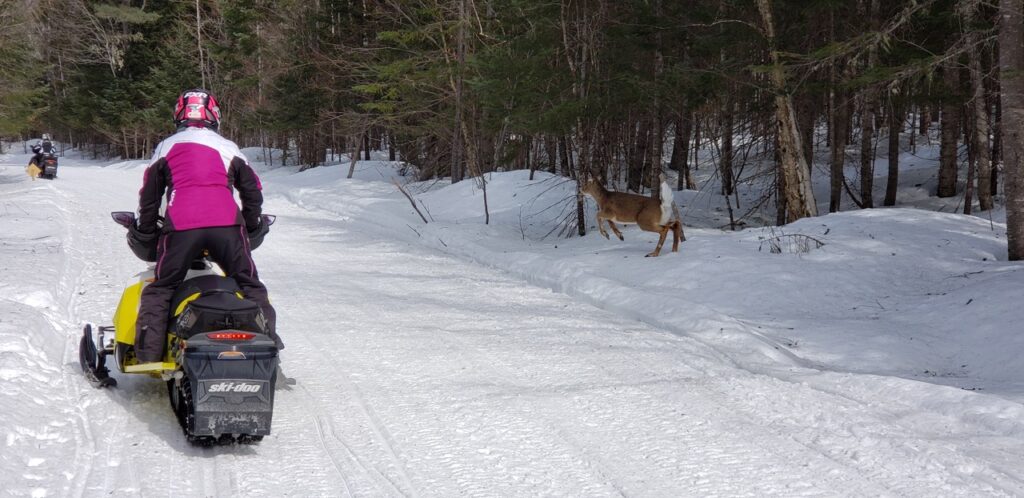Many Challenges For Talking Heads…
Related: Choosing The Right Snowmobile Helmet
Periodically, I see online posts asking about snowmobile helmet communicators. How well do they work? Which make is best? What’s everyone else using?
Personal Experiences With Snowmobile Helmet Communicators
Unfortunately, definitive answers seem to be few and far between. I know my own experience is mixed. When my snowmobile helmet communicators worked properly, I enjoyed being able to talk one to one with my spouse. But all too frequently, I had to fiddle with controls, mic positions or fading batteries. Or deal with atmosphere or terrain interference. Plus, recharging batteries nightly became one more nuisance to remember to plug in.
Moreover, I quickly discovered that each additional helmet communicator within my group compounded these frustrations. If just one was not working properly, it often impacted the reception or transmission of all others.
Not A Phone
I also still chuckle remembering one large group of about 25 riders. They talked my ears off over the airwaves. Over the first couple of hours amid much static and breakup, the gossip channel continued. I learned who was getting married, who was expecting, and what everyone’s kids were up to.
Maybe I’m a grinch. But at our lunch stop, I gathered everyone together and pointed at our helmet communicators. “These are not phones,” I said, “They are to help us snowmobile safely and share ride information. So please, stay off the mic unless you have something important or interesting to say pertaining to today’s ride.”
From there on, that channel was kept clear so the ride leader, organizer and sweep could stay in touch as needed. This enabled us to keep everyone together and to stop as one group. Additional benefits included making sure everyone knew where they were going. Also, when the next break was, and if anyone had stopped unexpectedly or needed assistance.
Not A Techy
Let’s continue with full disclosure. I have a smart phone. I also carry a Globalstar Satellite phone for out of cell service emergencies. However, I don’t listen to music while I ride. And I’m not interested in being interrupted by phone calls. But as already noted, the ability to talk directly with other riders appeals to me for safety’s sake and convenience. And contributes to our shared enjoyment.
Rider Reviews of Snowmobile Helmet Communicators
But similar to my experience, riders reviews online are mixed. Many are uncertain whether or not snowmobile helmet communicators are a good investment. A brand that one rider likes doesn’t seem to work as well for others. Some riders don’t like any of them. Others seem to be putting up with devices that function okay, but not as expected. So, reliability appears to be a crapshoot and here are some reasons why…
Challenges With Snowmobile Helmet Communicators
Primary Purpose
My first problem with snowmobile helmet communicators is this primary purpose, communication. That is, to interact verbally with companions to convey important, real-time intelligence pertaining to the ride. But this message often appears to get lost amid high tech features superfluous to head to head dialogue. I mean, what good is listening to music or being able to answer your smart phone while snowmobiling if you can’t talk reliably with your companions?
As my group leader, I’ve also found helmet communicators a challenge for reaching all riders in the group. For instance, 4 to 6 riders can be spaced out over several miles. And even passing through different terrain at the same instant. So reliably communicating with the last sled in line is a crapshoot at best. Not being certain of being able to talk to everyone at the same time can be frustrating. To say nothing of other riders getting mixed messages or incomplete info from the leader.
Not Specially Made For Snowmobiling
My second problem is that most so-called snowmobile helmet communicators are that in name only. In fact, their primary market is motorcycle riders. As proof, simply visit the websites of the major communicator brands. Do you see any mention of purpose-built snowmobile helmet communicators? Or any products specifically designed for winter? Instead, what’s on offer is generally designed and marketed for motorcycling.
So why is that important? Because motorcyclists typically ride on paved roads with wider corridors than trails. Meanwhile, their riding season occurs in warm seasons or comparatively moderate climes. Consequently, their helmet communication needs and challenges aren’t the same as for snowmobilers. But are any of these motorcycle helmet communicators re-engineered, adapted or otherwise upgraded for snowmobile use? Not that I’ve found…
Winter Riding
Consider for example, cold temperature. Cold freezes batteries and impairs device reliability. This exposure negatively impacts both range and longevity. Especially without insulation, better batteries or positioning protection them from the cold. So, it’s no surprise that motorcycle communicators are unlikely perform as advertised. That is, to achieve their claimed speaking distance, voice clarity or battery life in real world winter usage. They also aren’t water proof, which can be problematic if you get caught rain or sleet.
The way snowmobilers dress for the cold also makes motorcycle helmet communicators less effective on the snow. Face protectors, balaclavas, helmet breath guards and fighter pilot style masks can limit mic placement options and effectiveness. Moreover, while small control dials and buttons may be bare-hand/warm-weather friendly, snowmobile gloves make using them difficult at best. So do cold bare hands. And forget fine tuning on the fly if you wear mitts!
Spotty Reliability
My third problem with snowmobile helmet communicators is range and clarity. As already mentioned, cold plays a major role here. But so does terrain and trail layout. Unlike the roads where most motorcycling occurs, narrower snowmobile trails cross rugged wilderness hemmed in closely by trees and rock. What’s more, the only line many snowmobile trails follow is as a drunken crow flies. Twisty, turney and snaky.
And let’s not forget that snowmobile trails also go up and down hills, into and out of valleys, through gorges and over mountains. All of these severe terrain impediments interfere with helmet communicator transmission and reception. So, suddenly an advertised 2-mile broadcast range for motorcycles is dramatically reduced to 200 yards for snowmobilers. And clarity gives way to voice interference, cutting out, and inability to understand what’s being said.
Operator Error
All of which is not to say that helmet communicators won’t work for snowmobiling. But they are most reliable in good weather, in small groups, on flatter terrain and with good sight lines. And when everyone is using the same brand (maybe even the same model?).
Helmet communicators also work best when users bother to read the manual beforehand. And from it understand how to use them and to troubleshoot issues. It also helps when users test them out before going on a regular ride, same idea as putting a new sled through its paces on a trial run.
Like so many devices these days, snowmobile helmet communicators have improved considerably over the years thanks to technology advances. They are also packed with the latest high-tech features to attract digitally savvy riders who can’t stand to be disconnected from civilization for even an instant. But I don’t want to be a rocket scientist to use snowmobile helmet communicators. I just want to be able to talk on the snow with trustworthy reliability and no hassles. Is that too much to ask?
Shop For Helmet Communicators
My buddies at Sledaddicz sweat by their Cardo units, so check out the video for their take.
Sad News
Speaking of helmet communicators, Canadian company Collette Communicators were the pioneer of purpose-built devices for snowmobiling and also developed the “groomer warning beacon”. All thanks to founder Les Collett, who has sadly passed away. Now, with their inspiration and mentor gone, the family closed the doors on their business. I started with Collett Communicators back in the day, so thanks to the Collett’s for a great product, built by snowmobilers for snowmobilers.
The tips and advice in this blog are the opinions of the author, may not work in every situation and are intended only for the convenience and interest of the reader, who has the personal responsibility to confirm the validity, accuracy and relevancy of this information prior to putting it to their own use.





